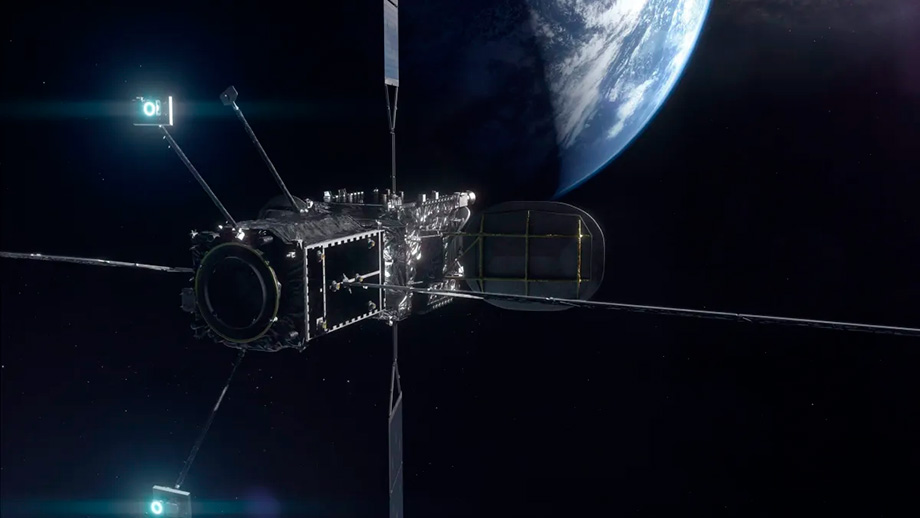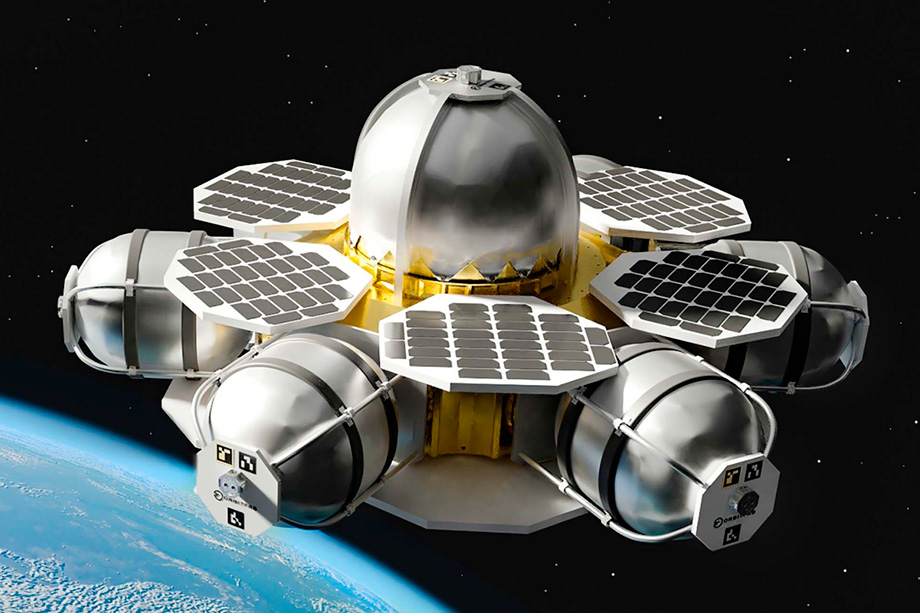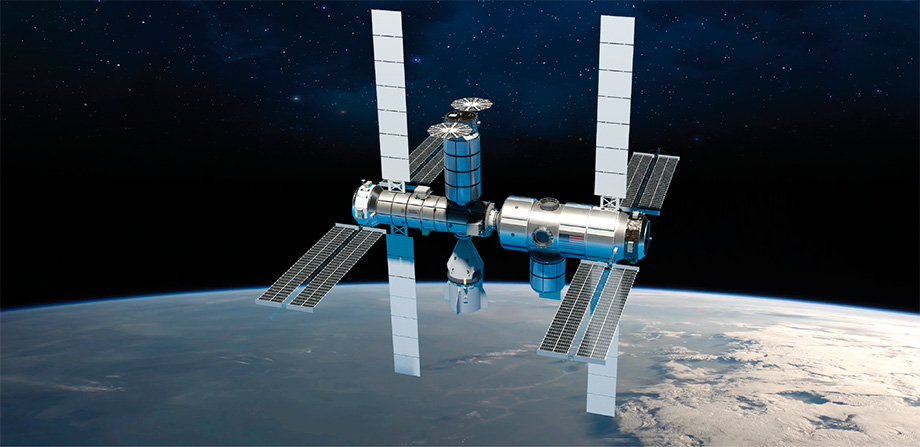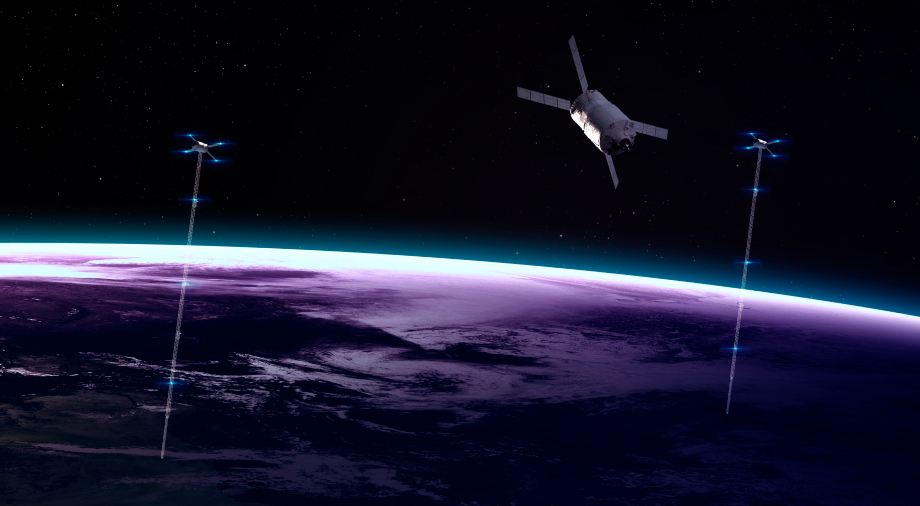Humanity has long used Earth orbit for its own purposes with great success. Satellites deployed there provide us with weather forecasts, communications, Internet access, and the ability to determine our location anywhere in the world. We should not forget about the military – no army today can combat effectively without support from space.
However, now, a revolution is taking place in orbit. The first mega constellations of satellites are being created in front of our eyes; private spacecraft are carrying people, and the prospect of commercial orbital stations no longer seems unreal. So let’s try to imagine what may await Earth orbit in the near future.
Space Technical Service Station
One of the main trends in the development of the near-Earth orbit will undoubtedly be the creation of the sector, which can be called Space Technical Service Station. The point is that modern satellites have already reached a high level of reliability. Yes, accidents still happen, but, in general, the service life of spacecraft is more often determined not by reliability of their systems, but by consumables, such as fuel reserves, as well as solar batteries and accumulator life span.
From a financial point of view, it’s much easier to refuel an outdated, but still fully functional satellite than to build and launch an entirely new one. Already now several tugs are successfully operating in orbit and are used to keep satellites that have run out of fuel in orbit. But this is just the beginning. Obviously, the future is not in this kind of individual approach, but in universal systems that can directly refuel many spacecraft.

Credit: Northrop Grumman
Sure thing, all this is not a matter of one day. Orbital refueling will require equipping satellites with universal refueling ports, as well as creating a network of space tankers and refueling stations. A number of companies are already working on such systems, and we even have the first figures on the cost of space refueling. For example, recently, the aerospace startup Orbit Fab announced that refueling a satellite in geostationary orbit would cost $20 million.
Still, as new players enter the market, prices will have to drop. Besides, if refueling large geostationary satellites is the priority now, in the future, we have the right to expect companies that will undertake servicing of smaller satellites.

Image: Orbit Fab
Orbital tankers and refuelers, although vital, are not the only areas of space service. One should not forget about upgrades: repair and installation of more up-to-date components, as well as completion of satellites. The replacement of solar batteries, which tend to degrade under the influence of radiation and micrometeorite impacts, is particularly of great interest.
At the time of the Space Shuttle program, they believed that such operations would be performed by humans. However, now it’s obvious that everything necessary can be achieved with the help of automation. In 2025, the Maxar-built OSAM-1 spacecraft, designed to refuel the old Landsat 7 satellite, is to go into orbit. Along with it, a five-meter robotic arm SPIDER (Space Infrastructure Dexterous Robot) will fly into space. It will have to build a functional antenna three meters in diameter, capable of transmitting signals in the Ka-band, and a 10-meter beam. If successful, the experiment will clearly demonstrate the possibility of building large structures in space without direct human involvement.

Image: Maxar Technologies
Another fairly promising area of exploration of Earth orbit is the creation of space power plants. Many space agencies and private companies are conducting experiments in this industry. China recently promised to build a prototype of the first solar power plant in space before the end of this decade.
Sure, in the near future, orbital power plants are unlikely to seriously compete with their ground-based counterparts. However, in the long term, they may well begin to play a fairly important role in the global energy industry. You can read more about the problems and prospects of this industry in our article.
Mega constellations and space debris
The Starlink satellite constellation is the first mega constellation in history. It currently has over 3,000 active satellites, but this is just the beginning. When fully deployed, Starlink will consist of more than 12,000 units with the possibility of further increase to 42,000.
At the same time, SpaceX is not the only player on the satellite Internet market. Thus, Amazon plans to create its own system of more than 3,000 devices. China also has plans to create its analogue of Starlink, and recently they have started talking about them in Europe. OneWeb is another example, as well as smaller constellations of other companies, designed to capture images of the Earth’s surface and provide communication services.
All this means that in the future, Earth orbit will become much more densely populated. Such densification creates a number of obvious problems, such as a significant increase in the risk posed by space debris. The more satellites in orbit, the higher the probability that one of them will be at risk of colliding with some object. In turn, such a collision will generate more debris, increasing the threat to other spacecraft.
Of course, no one in their sober mind wants to see a Gravity scenario in real life. Therefore, the same Starlink satellites are already equipped with a control system using artificial intelligence, capable of independently performing evasive maneuvers if necessary.
Also, active work on the development of technologies that will reduce the amount of space debris fragments already takes place. So far, it is mostly limited to experiments in order to find the most effective methods, but, as you know, demand breeds supply. The more satellites we have in orbit, the greater the demand for space debris services. With a high probability, we will see the appearance of companies that will specialize in orbital cleaning alone.

Another likely consequence of having tens of thousands of satellites in orbit is fundamental reform of the orbital traffic control system. Currently, there is no single space control room on Earth, a global system designed to prevent collisions in space. The leading space powers, as well as some space agencies, have orbital tracking facilities. However, they are not part of a common network and far from sharing data, which can lead to unfortunate consequences. Another problem is the lack of a common set of modern and universally accepted standards for the use of Earth orbit, similar to those for civil aviation.
Obviously, the current state of affairs cannot last forever. The more satellites are put into space, the more often potentially dangerous situations arise, the stronger will be the voice of those who advocate reforming the entire industry. Sooner or later, humanity will have to create a system of space traffic controllers to regulate orbital traffic.
People in space
So, in the foreseeable future, Earth orbit will become a much busier place. There will be a network of gas stations, to which space tankers will be regularly directed, and many specialized vehicles that will be engaged in the maintenance and repair of various equipment. All this will be accompanied by the deployment of colossal constellations that will change the view of the night sky on our planet forever. What about the human presence?
Despite the fact that the ISS is likely to operate until 2030, it’s clear that such a format, in general, can be considered a bygone conclusion. Some may argue that right now, the near-lunar station Gateway is in development, the creation of which involves the same countries (without Russia) that once built the ISS. But in this case, we are talking about a project that is part of a larger government program.
When it comes to Earth orbit, the future is clearly in the hands of commercial stations, which will be rented for scientific research, experiments, travel purposes, and any other activity that can be done in space – from advertising to filming movies. The main thing is the customer has the right amount of money. This situation is quite convenient for traditional aerospace agencies. After all, instead of being engaged in continuous supply, repair and maintenance of the orbital complex for many years (which amounts to an impressive sum), they can simply buy a place to conduct the necessary research.
This is why NASA has recently become very active in supporting such projects. After all, the faster commercial stations appear in orbit, the more resources the organization will be able to free up for other programs.

Credits: Northrop Grumman
It’s necessary to say a few words about orbital hotels, which have long been the Holy Grail of space tourism. Since the late 1990s, every few years, there have been multiple media headlines stating that in the near future, an orbital hotel will welcome its first guests. Each time, however, it did not go beyond general promises.
But now the situation has changed. The advent of affordable launch vehicles and private spacecraft for the first time in history has made the realization of such projects technologically possible. Right, it is still not a matter of one day. Nevertheless, one can cautiously predict that the first space hotel will receive guests for the foreseeable future.
Long-range astroprojects
All of the projects described above are quite feasible using modern technology, with the current trend towards lower prices and more affordable space launches. But what about the more distant prospect – the construction of full-fledged space settlements like the O’Neill colonies, orbital shipyards, and other large astro facilities?
As it usually happens when it comes to space, everything rests on the price of putting a kilogram of payload into orbit. At the moment, the cost of launching the world’s most popular Falcon 9 rocket is $67 million. With a maximum payload capacity of 22.8 tons in low orbit, this gives a notional figure of $3,000 per kilogram, taking into account that rockets almost never fly with a full load. This is almost an order of magnitude less than the cost of launching a kilogram of payload on the same shuttle, but still, quite a lot.
However, Elon Musk, for instance, promises that Starship will cost only 10 million dollars per launch (e.g., 100 dollars per kilogram of cargo), and in the future, the figure can achieve laughable figures of $1 million ($10 per kilogram).
Only time will show how true these statements are. But even if Starship does turn out to be a cheap and reliable spacecraft, it will still not be enough to implement a really big astroproject involving the rapid launch of millions of tons of cargo into Earth orbit.
A possible solution to this problem is not the delivery of all the necessary materials from Earth, but the use of local resources. This, for example, could be a small asteroid, captured and dragged into Earth orbit. It could then be used as a source of building materials, building solar panels, hull parts, antennas, beams, and other necessary elements with the help of 3D printers.
Looking even farther into the future, we can speculate on the concept of a space elevator – a structure in the form of a heavy-duty cable stretching from the equator to a station in geostationary orbit. It will allow the direct delivery of cargoes from the Earth’s surface to space without using rockets.

Space elevator is one of the most popular concepts in science fiction, but the possibility of its creation is still a subject of scientific discussions. That’s because construction of such an elevator will require creation of a material, capable to withstand huge loads and, at the same time, not to be folded under its own weight. The most promising candidate for this role are carbon nanotubes. In theory, they are solid enough for such a task. But in reality, scientists have not yet succeeded in obtaining nanotubes with parameters that would suit a space elevator. In addition, it’s necessary to figure out how to braid them into a cable thousands of kilometers long.
Still, even if the proper material is created, engineers will have to solve many other problems. For example, find a suitable location for the elevator, figure out how to protect it from hurricanes, space debris, exposure to radiation, etc. So it is not surprising that many experts are quite skeptical about the idea of such a construction.
We should also admit that a project of this magnitude cannot be accomplished by separate national governments or private companies. It would literally require the resources of the entire planet, which means that its realization would be possible if a relevant civilizational challenge were to be met. For example, the terraformation of Mars, the creation of giant solar power plants to completely abandon fossil fuels, or the construction of interstellar spacecraft.
So far, all of the above seems like science fiction. However, not so long ago, the idea of creating private spaceships also seemed almost unreal. So we cannot exclude that our nearest descendants will witness the start of such a mega-project.





